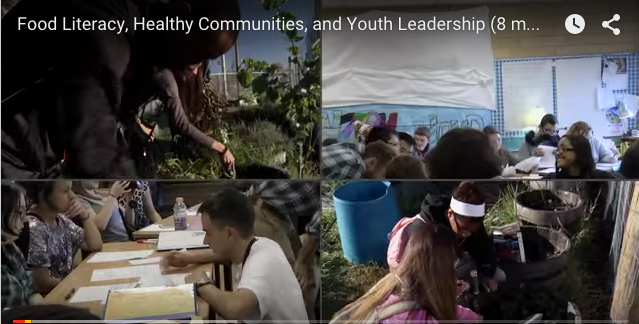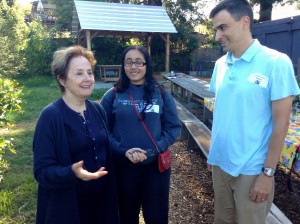Say Yes to Pears!
4October 26, 2015 by Tom McKenna


Brent Peters and a student speak with Alice Waters near the garden of the Edible Schoolyard at MLK Jr. Middle School in Berkeley, CA.
by Brent Peters
English and Food Literacy Teacher
Fern Creek Traditional High School
Louisville, Kentucky
BLSE ’16, funded by the C. E. and S. Foundation
Editor’s note: Brent Peters composed this piece in Professor Jennifer Wicke’s Critical Writing class at BLSE Vermont, Summer 2015.
We start our Food Lit. class at Fern Creek High School with a food map and an invitation to share stories. This map can lead us to 50 pounds of pears.
We write the word food on a piece of paper. Around it, we write all the glorious, revelatory, embarrassing, gross, and sometimes painful associations we have with food. We include the places and people who are connected to our food memories. The paper fills up quickly. Then we share. Nick is learning to make his grandpa’s legendary peanut butter fudge. Blanca shares her family’s tradition of making El Salvadorian papusas on Sunday nights and the accompanying call to her grandmother in San Salvador. Kenny teaches us about bubble tea from Vietnam, offers to bring in Pho and rambutans. Ivy tells us that her grandmother has a load of organic pears from the trees in her yard—that her dad just harvested them—and she can bring them in. Tomorrow. She has already texted her mom. Yes.
The first class proves to me that you can have a meal without any food, and that a word can be food. Our first class is a dinner table: we laugh, tell stories, and listen carefully. Our stories remind us of places, people, and tastes, actions that are in season in the territories of memory. We are filled with 50 pounds of compelling pear stories.
I meet Ivy’s mom in front of school the next morning when the front of the school is a parade of brake lights and quick goodbyes—a balancing act of book bags and warm drinks. She jumps out of the car. I introduce myself, help her open the car’s trunk, and as I heave the pears up, I watch the car visually stand up from the weight on the shocks. Wow, thank you so much. Thank you, she says. These pears would have gone to waste.
When you have 50 pounds of pears and a strict lesson plan, pears go to waste. You also get fruit flies. Which are gross. But pear butter, pear chutney, pear sauce, dried pears, and pear apple almond muffins are not gross, especially when a class works together to peel, core, and research pear recipes. We experiment, and we mess up . . . a lot. But messing up is how we get to all our delicious discoveries. And delicious discoveries lead us to lots of leftovers. We have enough pear creations to share with other students and staff, and we have enough of a shared experience to sustain a collective memory. We add a common reference point to our food maps. Ivy’s grandma’s pears. We are now on a journey together.
And we are learning in season.
In the food world, awareness surrounds what is local and seasonal. Pears are in season in the fall, so are the apples in our small orchard at FCHS and in the surrounding orchards in Kentucky and Southern Indiana. Greens like kale, chard, and collards are going haywire in the FC garden. Radishes pop up out of the soil and look like lollipops, carrots are popsicles, beets are bullseyes, and cilantro are like silky miniature palm trees. The last tomatoes announce themselves in full. They are splitting from late rain. Some call them seconds; we call them eat-them-nows. Butternuts and acorn squashes hide behind leaves and winding vines. Pumpkins bulge, as do cantaloupes and watermelons. Can we harvest some of these vegetables and have a class meal? Yes. We’ll save the gourds for the table decoration. And let’s invite Ivy’s grandmother as a way of saying thank you. Do you think she will say . . . Yes?
We do harvest these vegetables, and we prepare them with care for our first class meal. Roasted veggie burritos, tomato mole, a mixed green salad with watermelon, cucumbers, and a vanilla vinaigrette. We place them all on one big table, set up just outside the school entrance. Before we eat, we write. The prompt: What is a meal? During our meal, we talk about many things, but one of them is what a meal is and isn’t for us. Our definitions are as dimensional as we are.
We create the definition of what we want a meal to be when we have one together, and we return to our classroom with more than just a meal. The meal has made us hungry for a classroom where we all are in season. This realization goes deeper than the core of the pear, farther than the core of a table conversation, and beyond the Common Core; we are caring for the core of our identity by learning that what we care about and who we care about matters.
Ivy’s gran does join our class meal. She says she had no idea all of this was happening at school. And this is an English class, right? Yes. Food Lit. OK. It’s just that Ivy was explaining this, and I was having trouble understanding how it all connected. Now I see. Food and English. You are doing more than just being in a class. What else do you see? I see a lot of kids forming a community. I see that food is an unlimited metaphor. I see a classroom that looks like a family. And everyone looks hungry.
When we consume any food item, we are eat the story of that thing, too. When we eat one of Ivy’s pears, we eat the season, and we eat water, soil, land, weather, pollination, and family story. When we work in our school garden and eat from it, we take a bite out of our school. We become Fern Creek High School in a deep and philosophical way. One Food Lit. philosopher’s thoughts led to this question: If we eat from the garden and are Fern Creek, what are we when we eat school lunch? Well, we are more than dough, cheese, tomatoes, fruit salad, ranch dressing, plastic forks, styrofoam trays, garbage bags, compost bins, frozen-then-reheated, boxed-then-shipped; we are more than forgotten on the bus; more than nothings; we are far more than growling tummies; we are even more than homemade. We are creative, critical readers and writers who can take on big questions and read the world for the answers. If we can read a garden, then we can read a cafeteria. We can read the farmers’ market and the grocery store, the concession stand, and the vending machine. We should read these things because they are part of us, part of our day, and part of our identity.
By extension, when we make a cup of tea to go with our pear apple almond muffins, we become part of the tea’s story—its history, its location, and all the hands that went into making it. An almond connects us to the Central Valley in California—to bees, drought, hydrology, monoculture, climate change, to almond farmers, the plight of undocumented workers, to John Steinbeck and the Dust Bowl. A bite of an apple is bite out of the beginning of the Trojan War, of Atalanta and her golden apples, of the Garden of Eden paintings of the Renaissance, of resurging heirloom varieties, of genetics, of idioms like the apple of my eye, of Neruda’s odes, and of the Apple technology in our pockets. Food is our connection to the world, our passport full of stamps, our taste of time, language, literature and culture. Why not say yes to all these connections? In our class we just said yes to pears, and 50 pounds of possibility followed.
We said yes to what is in season, and we found a way to fuel a journey that may continue for us and our students—a journey to learning that tastes like good food in season.
Learn more about Mr. Peters’ recent work with food literacy.
Category BLTN Teachers, Fall 2015, Featured | Tags:

Brent, you are the man. An inspiring teacher and advocate for students. I’m just going to drop this quote here because you said it best:
“By extension, when we make a cup of tea to go with our pear apple almond muffins, we become part of the tea’s story—its history, its location, and all the hands that went into making it. An almond connects us to the Central Valley in California—to bees, drought, hydrology, monoculture, climate change, to almond farmers, the plight of undocumented workers, to John Steinbeck and the Dust Bowl. A bite of an apple is bite out of the beginning of the Trojan War, of Atalanta and her golden apples, of the Garden of Eden paintings of the Renaissance, of resurging heirloom varieties, of genetics, of idioms like the apple of my eye, of Neruda’s odes, and of the Apple technology in our pockets. Food is our connection to the world, our passport full of stamps, our taste of time, language, literature and culture.”
Brent, you are the man. An inspiring teacher and advocate for students. I’m just going to drop this quote here because you said it best:
“By extension, when we make a cup of tea to go with our pear apple almond muffins, we become part of the tea’s story—its history, its location, and all the hands that went into making it. An almond connects us to the Central Valley in California—to bees, drought, hydrology, monoculture, climate change, to almond farmers, the plight of undocumented workers, to John Steinbeck and the Dust Bowl. A bite of an apple is bite out of the beginning of the Trojan War, of Atalanta and her golden apples, of the Garden of Eden paintings of the Renaissance, of resurging heirloom varieties, of genetics, of idioms like the apple of my eye, of Neruda’s odes, and of the Apple technology in our pockets. Food is our connection to the world, our passport full of stamps, our taste of time, language, literature and culture.”
Always an inspiration, Brent!! Seeing all of the work you have done at Fern Creek first hand I am always impressed by your tireless care, concern and dedication. It is not often that we get to challenge students to think about themselves from the inside out, pushing them to investigate the foods they put into their bodies and the way that this shapes their minds and spirits. What an inspiring process to analyze and write about!
Always an inspiration, Brent!! Seeing all of the work you have done at Fern Creek first hand I am always impressed by your tireless care, concern and dedication. It is not often that we get to challenge students to think about themselves from the inside out, pushing them to investigate the foods they put into their bodies and the way that this shapes their minds and spirits. What an inspiring process to analyze and write about!